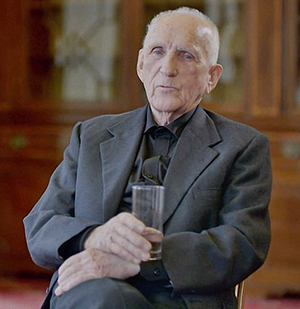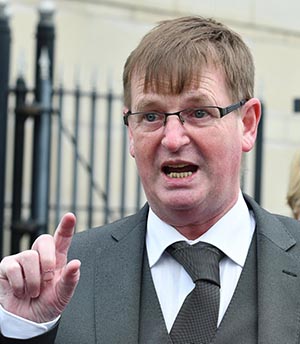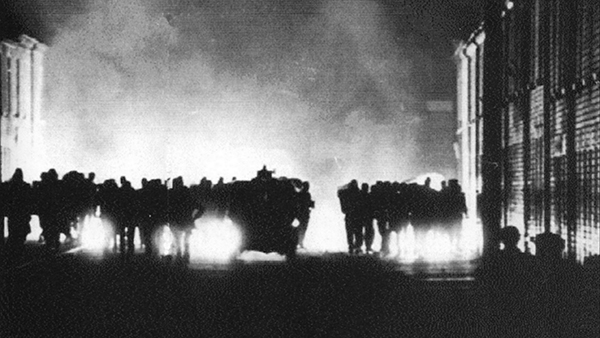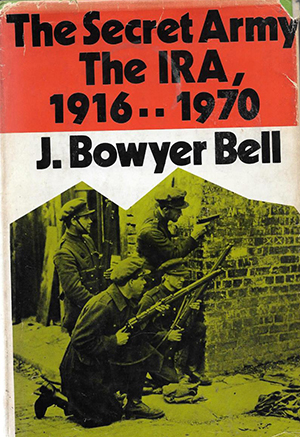Spotlight on the Troubles: a secret history
Published in Issue 1 (January/February 2020), Reviews, Volume 28BBC Northern Ireland and BBC Four
10 September–22 October 2019 (seven episodes)
By Brian Hanley
It is as well to admit at the outset that critiquing a television documentary could leave a historian open to the accusation of being jealous of the access to a popular audience enjoyed by a documentary-maker. As it happens, most historians I have spoken to profess to be underwhelmed by BBC Northern Ireland’s A secret history. A few were also annoyed that the mundane reality of research in archives was presented as drama, with documents discussed in hushed tones, when in fact some of what was being ‘uncovered’ had already been published in academic studies. In contrast, however, non-academic friends and acquaintances seemed much more enthused. Some remarked that they had been unaware of many of the incidents featured in the programme and that it inspired them to find out more.

Above: A line of RUC and B-Specials moves along Hooker Street in Catholic Ardoyne on the night of 14/15 August 1969, backlit by the fires of loyalist arsonists. (Belfast Telegraph)
Spotlight’s use of archival footage, including some previously unseen material, was very effective, but the desire to expose ‘secrets’ came with the assumption that most people already know the basic outline of what occurred during the ‘Troubles’. In reality, certainly in my experience, many simply do not. Occasionally during the series, what we were seeing on screen, such as film of the aftermath of the La Mon bombing, was not explained. A case could be made for making a series that simply spelt out what happened during the conflict, who the various actors were and how they justified what they did. BBC Northern Ireland certainly have the resources to do this, and their excellent series Pop goes Northern Ireland manages to summon up the chaos of those years very well. But Spotlight set itself a different task, claiming that, as ‘almost nobody tells the truth’ and ‘nothing is as it seems’, it would uncover hitherto unknown aspects of the conflict.

Above: The late loyalist ‘victims campaigner’ Willie Frazer was identified as a participant in loyalist paramilitary activity. (Colm Lenaghan/Pacemaker)
The programme-makers did succeed in gaining access to a number of players who had not spoken publicly about their involvement before. These included republicans John Crawley, Des Long and Fr Patrick Ryan, who illuminated different aspects of the IRA’s campaign. Dubliner Matt Treacy also gave a rare insight into the IRA south of the border and its members’ reactions to the final acts of decommissioning in 2005. Loyalist Laurence Maguire discussed his personal involvement in sectarian killings, while Spotlight named Alan Oliver as a key member of the Mid-Ulster UVF in the early 1990s. It also identified the late loyalist ‘victims campaigner’ Willie Frazer as a participant in paramilitary activity. Revd Ralph Baxter gave an account of the Feakle peace talks of 1974 and recounted how he was forced to leave Northern Ireland owing to threats from loyalists in their aftermath. Interviews with the families of victims illustrated the grim reality of the conflict’s impact. It must be difficult now for anyone to deny that there was systematic collusion between the State forces and loyalist paramilitaries. The levels of this collusion differed, of course, and there were probably distinct if overlapping varieties of it, but it was a reality.
Republicans, too, particularly those who romanticise the armed struggle in retrospect, might have found Kieran Conway’s mention of how the IRA’s internal security unit utilised torture uncomfortable. Similarly, the involvement of Boston gangster Whitey Bulger in arms-smuggling and Des Long’s recounting of a young volunteer’s desire to shoot ‘bluenoses’ illustrate some of the nastier realities of the IRA’s war. The confirmation that American author J. Bowyer Bell, whose history of the IRA, The secret army, was published in 1970, had CIA connections confirmed long-held suspicions. What is surprising, however, is that, despite these worries, republicans gave him unprecedented access and warmly welcomed his book.

Above: A line of RUC and B-Specials moves along Hooker Street in Catholic Ardoyne on the night of 14/15 August 1969, backlit by the fires of loyalist arsonists. (Belfast Telegraph)
In my opinion the programme missed an opportunity to use the 50th anniversary to tell the story of the birth of the conflict from multiple angles. Interviews with British soldiers present in Derry during 1969 and the sister of a man shot by troops on the Shankill that autumn illustrated that there are many still alive who could have contributed to this. Given the seminal importance of Belfast during August 1969, more attention should have been devoted to recounting how events unfolded there. While there was some discussion of the split in the republican movement, the Official IRA, which was central to much of the early conflict, was not mentioned once in the entire series. Indeed, Spotlight cryptically described Stormont minister John Taylor as being shot by a ‘separate wing of the IRA’, though what this would mean to the average viewer is unclear. As the Irish National Liberation Army (INLA) emerged from a split with the Officials they were not discussed either. But aside from their own, often-deadly activities, the INLA was a significant force in the H-Block protests and three of its members died on the 1981 hunger strike. Was there a belief that the viewing public wouldn’t understand the politics of these organisations and therefore it was best not to mention them? Neither was the dynamics of paramilitary loyalism, which remains more diverse than may seem apparent to outsiders, explained.

Above: Long-held suspicions that the American author J. Bowyer Bell, whose history of the IRA, The secret army, was published in 1970, had CIA connections were confirmed.
The emphasis on ‘secret history’ serves a further purpose, however. While most people were relieved that the conflict was slowly brought to an end by the late 1990s, some feel uneasy that northern politics is now dominated by what they see as the ‘extremes’ represented by Sinn Féin and the DUP. This view is particularly well represented in academia and the media. The suggestion that compromise was forced on the IRA, in particular, through its infiltration by agents and the impact of directed loyalist terror enables some to hope that the ‘winners’ in fact lost. Though this is contestable, the very fact that this infiltration is ‘secret’ means that it cannot be disproved. That there may be political reasons for compromise and that some of this can be traced through analysing republican support at a popular level might not offer the drama provided by spies and informers but it might provide clues as to why the conflict ended when it did.
Brian Hanley is the author (with Scott Miller) of The lost revolution: the story of the Official IRA and the Workers’ Party (Penguin
















